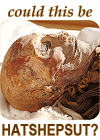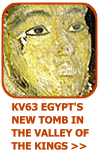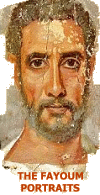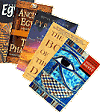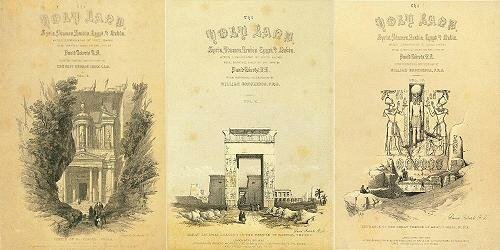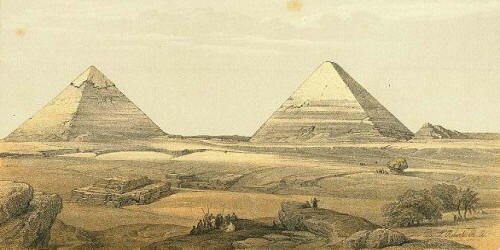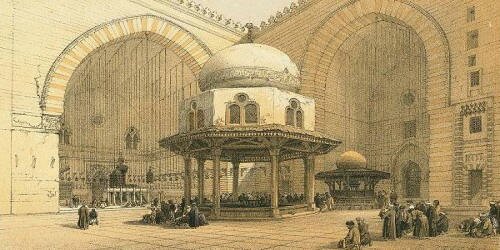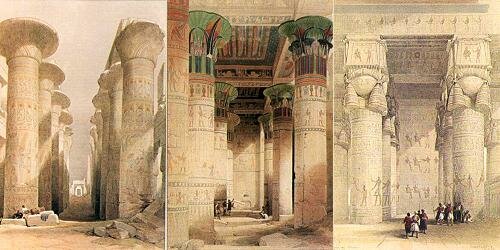|
|
||||||||||||||||||||
|
|
Topics in this section: david roberts | francis frith David Roberts The Scottish artist, David Roberts (1796-1864) was the first British artist to sketch the fantastic monuments of ancient Egypt. In the course of two and a half months in 1838, travelling some 800 miles south from Cairo, David Roberts recorded the monumental temple sites along the Nile in more than a hundred sketches. In 1839 he undertook the second part of his journey, leaving Cairo in the company of two friends, travelling through Suez, Mount Sinai and Petra, and continuing on up through the Holy Land and into modern day Lebanon. Having visited the most remarkable places from Dan to Beersheba, he finally returned home after some eleven months.
Upon his return, David Roberts submitted his drawings to F.G Moon in London, an enterprising publisher, who arranged for Roberts to superintend their reproduction into lithographs, a task entrusted to a Louis Hague. Preparing the plates for production took almost eight years.
Louis Hague's skill and delicate lithography and dramatic sense, combine in what are undoubtedly remarkable examples of lithographic work. The fruits of David Roberts's work have a worldwide reputation that nothing can bear comparison to.
Biography David Roberts was born at Stockbridge, Edinburgh, on 24th October 1796, one of five children born to Christine and John Roberts, a shoemaker. At the age of twelve, Roberts was apprenticed to an Edinburgh decorator, Gavin Beugo. The work was demanding, but the training was to prove invaluable. The prosperous middle classes in the fashionable New Town were developing a taste for the more refined aspects of interior decoration. Roberts soon mastered the techniques of marbling, wood graining and trompe d'oeil panelling. In the evenings he would study art. After having served his apprenticeship with Beugo, Roberts was offered a contract as a scene painter with a travelling circus, and was to spend the next 15 years designing sets for theatres throughout Britain.
In 1820 he had met one Clarkson Stanfield, who was then painting at the Pantheon, Edinburgh. At his suggestion, Roberts had sent three pictures into the Exhibition of Works by Living Artists, held in Edinburgh in 1822. In the same year he had moved down to London, where he initially worked for the Coburg Theatre, and was afterwards employed, along with Clarkson Stanfield, at Drury Lane. In 1824 he exhibited a view of Dryburgh Abbey at the British Institution, and sent two works to the first exhibition of the Society of British Artists. That autumn Roberts visited Normandy in northern France, and it was the artwork that he produced during this trip that began to lay the foundations of his growing reputation. One of works he produced - a view of Rouen Cathedral, was sold for eighty guineas. In 1829 he exhibited the "Departure of the Israelites from Egypt", in which his style first becomes apparent, but by 1830, Roberts had abandoned the theatre. He was determined to pursue a career as a landscape and architectural artist, and had already earnt himself a reasonable reputation as an easel painter. In 1831 he was elected president of the Society of British Artists.
In 1832 he travelled to Spain and Tangiers, returning in the end of 1833 with a supply of effective sketches, elaborated into attractive and popular paintings. His "Interior of Seville Cathedral" was exhibited in the British Institution in 1834, and sold for £300; and he executed a fine series of Spanish illustrations for the Landscape Annual of 1836, whilst in 1837 a selection of his "Picturesque Sketches in Spain" was reproduced by lithography and published in 1837. The success of his Spanish sketches and lithographs convinced Roberts that there was a growing demand for visual images of "exotic places". And so it was that he took the decision to travel in an area of the world which, to the Victorians, was the most evocative of all - the Holy Land. The great Biblical epic of the Exodus was to be his starting point.
You can now order David Roberts books online from this site!
If you are a collector of David Roberts lithographs of Egypt and the Holy Land, then you may be interested to know that we have a large selection of Day & Son smaller edition lithographs (pictured top row) available for sale. Published in 1855, these smaller editions are available unframed and unmounted in both full and half sized plates (as are the folio editions) and have a natural colour wash. Many scenes are currently available and these small lithographs are reasonably priced in comparison to the folio editions. Please contact us for details. Discover the photographs of Francis Frith >>
|
|||||||||||||||||||

|
||||||||||||||||||||
|
||||||||||||||||||||




